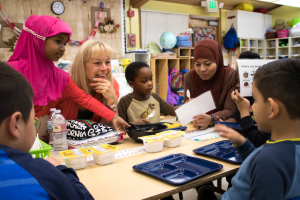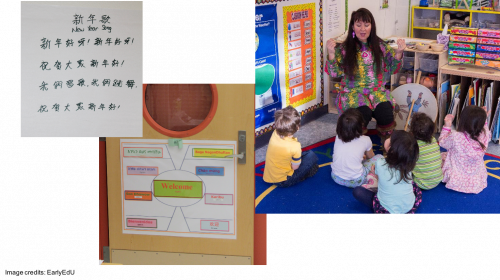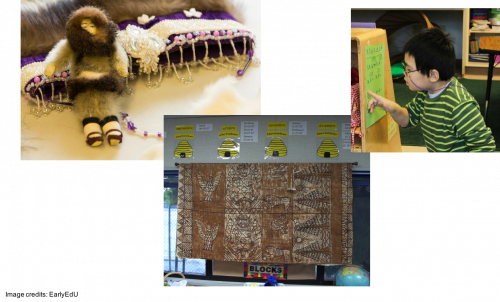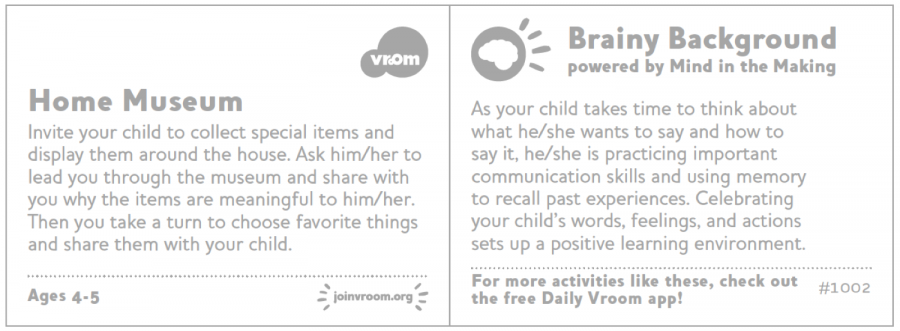12-2 Multiculturalism
A – Everyone Has A Culture!

We all come from somewhere and identify with at least one culture.
Many of us identify with more than one culture. Perhaps your grandparents were immigrants and taught you about their home country, but you may also affiliate yourself with the customs and traditions of a particular religion or the culture in which you grew up.
Each person’s personal history informs their cultural identity. This culture becomes transmitted across generations and evolves.
Culture can determine everything from the language we speak to the holidays we celebrate, the foods we eat, and the clothes we wear.
Culture can also influence child development. Different cultures have different beliefs about childrearing practices and even different beliefs about what children should learn as they grow. For example, in some cultures, toddlers are expected to feed themselves. In other cultures, parents feed toddlers.
Cultural Learning Begins In Infancy
Children begin learning about their culture from the moment they are born. As you have learned during this course, infants are beginning to learn the sounds of the languages to which they are exposed, and newborn infants are able to imitate the facial expressions of the adults around them.
Children’s cultural learning continues throughout childhood. Children are keen observers of the world, and they learn about culture and customs by watching the adults around them.
For example, if children observe that each time they walk into the library with their family their mother starts to whisper, the child learns that in their culture, it is proper to whisper in a library. Similarly, a child who notices that each mealtime begins with a prayer learns that part of their culture is to pray before mealtime.
As children develop, they are increasingly able to participate in cultural practices. They might help make the special meal, attend a ceremony for the first time, or even explain the cultural belief to a friend.
Language and Culture

Language plays a critical role in the development of cultural identity.
Culture often determines whether children will grow up speaking one or more languages. If children’s parents come from two different cultures—and two different languages—then a child might grow up in the same way. If parents share a culture, then children are likely to speak the same common language as their parents.
Not only is a family’s home language often determined by their culture, but many aspects of culture are transmitted through language. Native American communities, for example, hold all ceremonial events in their heritage language. In tribal communities where heritage languages are endangered, many communities engage in efforts to preserve the language and thereby preserve many important aspects of their culture.
Identity Development
Identity is a multi-faceted concept. It includes:
- Who you are
- What you value
- What directions you pursue in life.
Since culture influences so much of who we are, what we value, and the directions we pursue in life, it’s important to consider the identity of the children and families with whom we work.
Many theorists, like Erik Erikson, believe that identity is not really formed until adolescence. Nevertheless, children’s early years play an important role in providing a strong foundation for their later identity formation.
Children’s social and emotional connections during childhood are important for later identity formation. Children who have better attachment relationships with their families have an easier time figuring out their identities as teenagers. Researchers think this is because children with secure attachments to their family can voice their own opinions and seek guidance from family as they form their identities. Thus, early social and emotional connections are an important part of supporting children’s identity development.
It’s also critical for parents to expose children to elements of culture that they value. Over time, children will include these customs and traditions into their cultural identity.
Remember that even though children are just beginning their cultural journey, children’s families have already formed their identity.
Honoring Cultural Identities

Once children have begun to form a cultural identity, it is important to help them honor this in their early learning setting. Early childhood educators can help to reflect the cultural diversity of children in their program by including books from other cultures, displaying signs with multiple languages, and celebrating a variety of holidays and traditions throughout the year.
Educators can also work to pronounce each child’s name accurately, thereby honoring their heritage. They can learn to say a few words in each child’s language. Again, this honors the culture and lets every child know that they are important and valued.
Remember that families are an asset for developing a culturally relevant program. Families can provide books, translations, and information about holidays. Families can also provide in-person support to the program if they are welcome to visit.
If you are in an early learning environment with children who speak multiple languages, teach children to communicate across languages. This may be through gestures at first and simple words later. This not only builds cultural understanding, but it also develops children’s creativity.
Honoring each child’s cultural identity at their early learning program not only makes children feel welcome and at home, but it also demonstrates that the program values the diversity of its families.
Vroom Tip
Check out this Vroom Tip to get ideas about how to support multiculturalism. This activity can be given to families at the beginning of the year to help populate the early learning program with culturally relevant items.
Does this tip make sense in the context of an early learning environment? If not, how will you adapt the activity to better fit that environment?

View text-only alternative of this Vroom card
Home Museum
Invite your child to collect special items and display them around the house. Ask him/her to lead you through the museum and share with you why the items are meaningful to heim/her. Then you take a turn to choose favorite things and share them with your child.
Ages 4-5
Brainy Background powered by Mind in the Making
As your child takes time to think about what he/she wants to say and how to say it, he/she is practicing important communication skills and using memory to recall past experiences. Celebrating your child’s words, feelings, and actions sets up a positive learning environment.

Reflection Point
Use these points to consider the importance of honoring culture in early learning environments:
- Describe the diversity of cultures represented in your early learning program.
- What is one new way to honor culture in your program?
- What are the similarities between family engagement and multiculturalism?
B – Stereotypes in Childhood
 Interactive: The Development of Stereotypes
Interactive: The Development of Stereotypes
This is an interactive! Use the slider to explore the graph.
The last stage in this timeline is that a short time after children learn about stereotypes, they may state that they have changed their interest in subjects according to the stereotype. For instance, a girl may say, “I don’t do math.”
The danger is that these stereotypes and conformity to them may cause children to experience an opportunity gap or even influence children’s academic performance. Boys and girls do not innately have different math abilities, but internalizing the stereotype has negative consequences. For both genders, children who had stronger implicit math self-concept or the internalized idea that I’m a math person tended to do better on math tests.
 Interactive: Long-term Effects of Stereotypes
Interactive: Long-term Effects of Stereotypes
This is an interactive! Use the slider to explore the graph.
Even though this research examines the effects of stereotypes in older children, it is important to understand and combat the roots of stereotypes to prevent children from internalizing them.
Combating Stereotypes
The good news is that stereotypes are not innate or fixed, and we can give all children opportunities to learn.
For example:
- We can expose children to mathematicians who don’t fit the stereotype of an old white man. We can introduce role models in the community who embrace math and who may give children something to which they can aspire.
- We can expose children to a variety of experiences regardless of their culture, such as giving every child the opportunity to cook for the group, even if it’s pretend cooking.
- We can discuss and celebrate cultural and other differences so that children do not think these topics are off-limits for discussion.
- We can make sure not to reinforce differences unintentionally. Instead of saying, “Good morning boys and girls!” we can say, “Good morning children!”

Reflection Point
Use these questions to think about stereotypes:
- What stereotypes do you think affect the children in your early learning program?
- How can you provide positive counterexamples to combat stereotypes?
 References
References
Cvencek, D., Fryberg, S. A., Covarrubias, R., & Meltzoff, A. N. (2017). Self-concepts, self-esteem, and academic achievement of minority and majority North American elementary school children. Child Development. [Online Article]
Cvencek, D., Meltzoff, A.N., & Greenwald, A.G., (2011). Math-gender stereotypes in elementary school children. Child Development, 82(3), 766-779.
Cvencek, D., Nasir, N. S., O’Connor, K., Wischinda, S., & Meltzoff, A.N. (2015). The development of math–race stereotypes: “They say Chinese people are the best at math.” Journal of Research on Adolescence, 24(4), 630-637.
Kuhl, P. K., Tsao, F., & Liu, H. (2003). Foreign-language experience in infancy: Effects of short-term exposure and social interaction on phonetic learning. Proceedings of the National Academy of Sciences, 100(15), 9096-9101.
Meltzoff, A. N., & Moore, M. K. (1977). Imitation in newborn infants: Exploring the range of gestures imitated and the underlying mechanisms. Developmental Psychology, 25(6). 954-962.
Nemeth, K. (2016, November 16). Fast 5 gamechangers help diverse children respect each other. [Blog Article]
Schwartz, S. J., Côté, J. E., & Arnett, J. J. (2005). Identity and Agency in Emerging Adulthood. Youth & Society, 37(2), 201-229.
U.S. Department of Health and Human Services, Administration for Children and Families, Office of Head Start. (n.d.) Culture & language: Multicultural principles for early childhood leaders. [Online Article]
Vroom. (n.d). Vroom tips. [PDF]
EarlyEdU Alliance (Publisher). (2018). Sentence. In Child Development: Brain Building Course Book. University of Washington. [UW Pressbooks]

